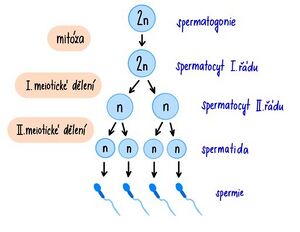Sperm
From WikiLectures
Sperm are male gemets. hey are capable of active movement and serve to fertilize the female gamete – oocyte. They are sometimes called spermatozoa because of their flagellum movement.
construction[edit | edit source]
- Head – by mass, the largest part of the sperm, contains a nucleus with haploid genetic makeup (n) and cytoplasm. In the front part of the head is a pouch called an acrosome , which was formed during spermatogenesis by the fusion of the pouches of the Golgi apparatus . It fulfills the function of a lysosome and serves to disrupt the structures surrounding the oocyte (corona radiata and zona pellucida). It contains several hydrolytic enzymes such as hyaluronidase (splits glycosaminoglycans), acrosin (protease), neuraminidase or acid phosphatase .
- Neck – structure connecting the head and flagellum.
- Flagellum –the part of the sperm allowing its movement. It contains a bundle of microtubules anchored in the basal body. It consists of three segments:
- Connecting (middle) segment- contains a number of mitochondria providing energy for movement.
- Main segment.
- End part
The size of the sperm is around 65 μm, of which only 5 μm is the head, the rest is the flagellum.
Development[edit | edit source]
- Sperm develop from spermatogonia through the process of spermatogenesis , consisting of the meiotic division of spermatogonia and the subsequent differentiation of spermatids (already haploid cells) into the final sperm. This differentiation includes acrosome formation, condensation and elongation of the nucleus, development of the flagellum, and loss of most of the cytoplasm. All spermatogenesis takes place in the seminiferous tubules of the testes. In other parts of the male genital system, several maturation processes occur, the disruption of which can affect fertility.
- The ability to fertilize an egg also requires so-called capacitation . This occurs only in the female genital tract. The process of capacitation includes, for example, the fusion of the cytoplasmic membrane in the area of the acrosome with the acrosome membrane, which enables the easier release of acrosomal enzymes after the contact of the sperm with the oocyte. The mechanisms of capacitation are not yet fully understood.
Development takes 64 days.
Sperm quality[edit | edit source]
Infertility can have many causes.
- The problem of modern times is the decreasing amount of sperm in ejaculation. While in 1938 the standard sperm count per 1 ml of ejaculate was 120 million, today it is only 25 million. Overheating of the testicles is to blame, for example, by frequent saunas or placing a laptop on the lap, a sedentary lifestyle, poor-quality diet or irregular sex.
Immotile sperm syndrome[edit | edit source]
It is caused, for example, by the malfunction of dynein, which is essential for the movement of the flagellum. But other proteins important for movement can also be damaged. Since this disorder affects all flagella and cilia, it is usually associated with chronic inflammation of the respiratory tract, the lining of which is formed by ciliated epithelium.
Links[edit | edit source]
Related Articles[edit | edit source]
References[edit | edit source]
- JUNQUIERA, L. Carlos – CARNEIRO, José – KELLEY, Robert O. Základy histologie. 1. edition. H & H 1997, 0000. 502 pp. ISBN 80-85787-37-7.
- VOKURKA, Martin – HUGO, Jan. Velký lékařský slovník. 8th edition. Maxdorf, 2009. 1144 pp. ISBN 978-80-7345-166-0.
- MOORE, Keith L – PERSAUD, T. V. N. Zrození člověka. 1st edition. ISV, 2002. 564 pp. ISBN 80-85866-94-3.





